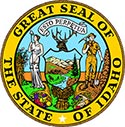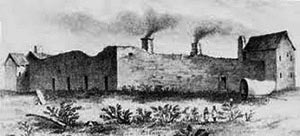Cache Valley in Idaho ~ Index
Early exploration of Idaho by trappers, establishment of Fort Hall and scientific expeditions into the area. First Indian mission efforts, naming of Idaho, Franklin being the first permanent settlement in the state.

For a number of reasons Franklin, Idaho has an interesting history. It was the first permanent settlement in Idaho, although at the time it was thought to be a part of the Territory of Utah. Being the farthest settlement north of those in the valley for several years and on the direct Indian trail through the valley, it had a number of thrilling experiences.
As an introduction to the account of the early history of Franklin, it is appropriate to mention a number of the first discoveries of Idaho. Much of the following information is taking from the historical account of Franklin, compiled in 1910 by Mr. S.P. Morgan for the Idaho Semi-Centennial Celebration.
The name Idaho is generally supposed to be a corruption of an Indian word, E-dah-hoe, meaning "The Gem of the Mountains," some claim that it means in the Indian tongue, "Shining Mountain," but the terms are closely synominous. The poet Joaquin Miller claims that the honor naming Idaho belongs to Colonel Craig and dates from 1861. Another writer claims that the word Idaho is not a Nez Perce word and says, The mountain that Joaquin Miller speaks of may be named with somewhat similar appellation, but most likely the whole story grows out of the fertile imagination of the poet. Idaho springs, Colorado, were known long before Idaho Territory was organized.
Colorado should have been named Idaho. It was the name first placed in the bill which created Colorado and afterwards was changed.
Pleased by the beauty of the country, William H. Wallace the delegate to Congress from the Washington Territory, introduced a bill in Congress creating a territory out of the eastern part of Washington and suggested Idaho as an appropriate name. The name was adopted and ex-Senator Nesmith of Oregon, states that it is familiar with the Nez Perce, Shoshone and Flat Head Indian tribes.
First Discoveries
So far as authentic records show, the first white man to enter Idaho were the party that accompanied Lewis and Clark on their exploring expedition in 1805-1806. They passed through the state and along the Snake River which they called Lewis Fork, to its junction with the Columbia. The following year they returned through Idaho, did some exploring and named several streams and places, such as Horse Plains, Red Rock Creeks and Fish Creek: Salmon River they called Sammanah and Quamash Flats, now known as Camas Prairie.

In the early fall of 1824, Jim Bridger who was in charge of a group of trappers of the Rocky Mountain Fur Company, entered Idaho along the Bear River south of the present site of Montpelier. They followed the course of the river and made stops at the springs now called Soda Springs. They continued to follow the river through the valley now known as Gentile Valley and entered Cache Valley, then called Willow Valley, in 1824. In 1843, Captain Charles C. Fremont, with a company of men, practically followed Bridger's course into Idaho and Cache Valley along the Bear River. Fremont was on a scientific and exploring expedition and took considerable time to study and gather specimens of the insect and plant life and to observe the habits and customs of the Indian groups he encountered.
Another expedition to come to the "Gem of the Mountains" or Idaho, was Captain Bonneville who with one-hundred men came during the year 1834 in his search for the outlet of Lake Bonneville. He explored the southeastern part of Idaho and traced the Port Neuf River to the Snake. Both of these expeditions were merely exploring parties and made no attempt at settlement.

In the same year, Nathaniel J. Wyeth, in his trip across the continent, established "Old Fort Hall" on the east bank of the Snake River north of the present site of Pocatello, Wyeth sold "Fort Hall" in 1836 to the Hudson's Bay Company, an English firm. During 1835, this company had already established a trading post at "Fort Boise." Both of these trading posts were abandoned by the Hudson Bay Company when the United States gained undisputed title to the land.
The Indian Mission at Lapwai some twelve miles from the present site of Lewiston, Idaho, was established during the year 1836 and was the first mission to be founded in the state. During the year 1839, the missionaries of the Sandwich Islands presented to the Presbyterian Mission of Oregon, a printing press. During the same year the press was taken to the Lapwai Mission, set up with type and put into operation by O.E. Hall. Books were printed in the Nez Perce language to be used in the Indian schools. This was the first printing office on the Pacific Coast of the United States, or in the west.
Other missions and trading posts were established in various places and at different times thorough the state but, with those already mentioned, were subsequently abandoned. It remained for a later group to establish the first real and permanent settlement in Idaho.